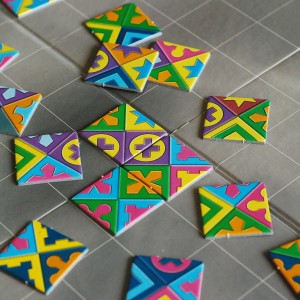Between the light and darkness of mathematical knowledge exists an ever-extending boundary that pushes the limits of abstraction into the framework of tangible existence. What can and cannot be known converges with each symbol in a collection of coherent logic. Step after step of pure reasoning reveals an underlying component connecting complexity with simplicity. Oftentimes, this sought after link is not easily discovered. This is immediately true for the ever-growing list of proposed problems that span the entire spectrum of mathematics.
This notion also holds true for problems and puzzles that pose a more recreational nature. I was introduced to one such puzzle during a talk given by the English mathematician Oliver Riordan during my undergrad years at the University of Memphis. Riordan was presenting the methods he and his colleague, mathematician Alex Selby, used to solve the first version of the conundrum known as the Eternity Puzzle. In late 2000, with a combination of intuition, combinatorial reasoning, and statistical inference, Riordan and Selby were able to place all 209 irregularly fashioned pieces of the puzzle in a dodecagon shaped board and claimed the £1 million prize from the puzzle’s inventor, Lord Christopher Monckton.
This was somewhat of a shock since the Eternity Puzzle has an estimated combinations and it would take anyone using brute force computation longer than the entire age of the Universe to compute all possible combinations in hopes of finding a solution. However, mathematics is an employable tool often used to supplant computational complexity. Such was the case with the solution to the Eternity Puzzle.
With the success of selling over 500,000 copies of the first puzzle, Monckton recruited Riordan and Selby to help invent a second version of the puzzle known as the Eternity II Puzzle. Unlike the first version, the Eternity II is very much unsolved. The only people that know of a solution are its creators. Also, unlike the first version, there are 256 square pieces with designs in four directions such that any solution on the 16 x 16 gridded board must preserve a pairwise edge-matching in every direction (see above picture). From its release in 2007, a $2 million prize was offered for its solution that has since expired in 2010.
When I graduated from the University of Memphis, some administrators in the math department gave me one of the copies of the puzzle that Riordan brought with him for the talk. On several occasions I have attempted to solve it with no success. Maybe one day a solution will emerge from the depths of complexity into the realm of simplicity.


The title of the blog post made me wonder , and after reading all I now have the an insight why it is still unsolved. Good share Avery , I will read the next article about Knot Garden.
Thank you Catherine.
I want to solve this puzzle.
How can find and solve?
hi… do you know how to encode eternity II as a SAT problem?
The puzzle has approx 10^500 something permutations of the 256 tiles.
Try computing the size of the observable universe in cubic Planck volumes, it’s on the
order of 10^128 or something. A cubic Planck volume is really small about 10^-35 cubic meter.